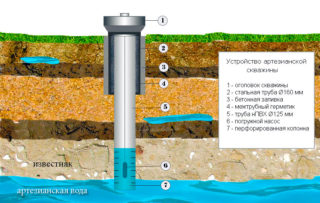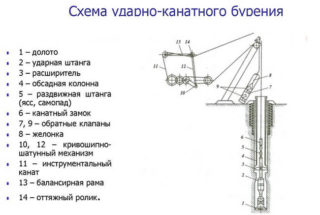When buying a plot with a private house outside the city, you should take care of the source of water supply. If the centralized communication networks are far away, it is necessary to equip the well. One of the options is drilling a well for limestone.
Artesian well device
- Perforated casing. Acts as a filter for the water entering the thief, preventing groundwater and sand from getting inside.
- The cut-off pipe is one level higher. Protects the water supply system from floaters that can enter it from the upper aquifers.
- Even higher is the static level, which is located in the sandy aquifer.
The well for water has an unequal diameter along its entire length. At the base, the largest width, deepening, the pipes narrow and reach the minimum section in the limestone layers.
Drilling technology
You can drill an artesian well into limestone in several ways, each of which has its own characteristics:
- Shock rope. Based on the use of the Earth's gravity. Drilling is carried out using a heavy percussion mechanism, which is lifted to a height using ropes pulled through the blocks to facilitate the work. With each new hit on the surface, the hammer is driven deeper, carrying the rock to the surface.
- Screw (auger). The hole in the rock is made using a drill with a special tip and spiral edges. As they rotate, they lift the soil upward and deepen. The method is good in that it is not limited to the depth of drilling, if you use an electric drive to rotate the mechanism.
The hydrodynamic method, in which the rock is washed out to the surface under the action of a strong pressure of water supplied manually into the thief during the process, is not suitable for an artesian well, since it reaches the limit after 15 - 20 m.
Benefits of an artesian source
The limestone layers are isolated from the groundwater, which prevents sediments like sand from entering the water intake. An artesian well is durable - it will last more than 20 years.
Considering that there is a high concentration of liquid in the limestone layers, at least 4 - 5 cubic meters of water can be pumped from the source in an hour. m of water.
The water quality is high - there is no need to install a special filter in the water horizon itself. It is enough to use a perforated casing string, which you can do yourself.
Cons of drilling for limestone
A limestone well has its drawbacks:
- Since the depth of the bailer is large, you will need to equip it with casing pipes. Moreover, the footage is proportional to the depth, which entails additional expenses.
- To drill an artesian well to a depth of more than a hundred meters, you need to use special equipment, including roller cone bits.
- The cost of the work will not please the owner of the site. Drilling 250 m is expensive. In addition, a source license is required, the cost of which starts from 500 thousand rubles.
It should also be borne in mind that there may be a need for unforeseen maintenance of the bailer. If a casing rupture or other malfunction occurs at a depth of several hundred meters, it will be very difficult to solve the problem due to the inaccessibility.
The main criterion for choosing between a sandy and an artesian well is the volume of water that is planned to be obtained from the depth. If you need a large flow rate of liquid, amounting to 4 - 5 cubic meters. m per hour, you definitely need to stop the choice on the limestone layer. This is more typical for enterprises and industries. For a small plot for one family, it is enough to dig the bailer down to the sandy layer, which brings less volume, but is more economical to organize.











